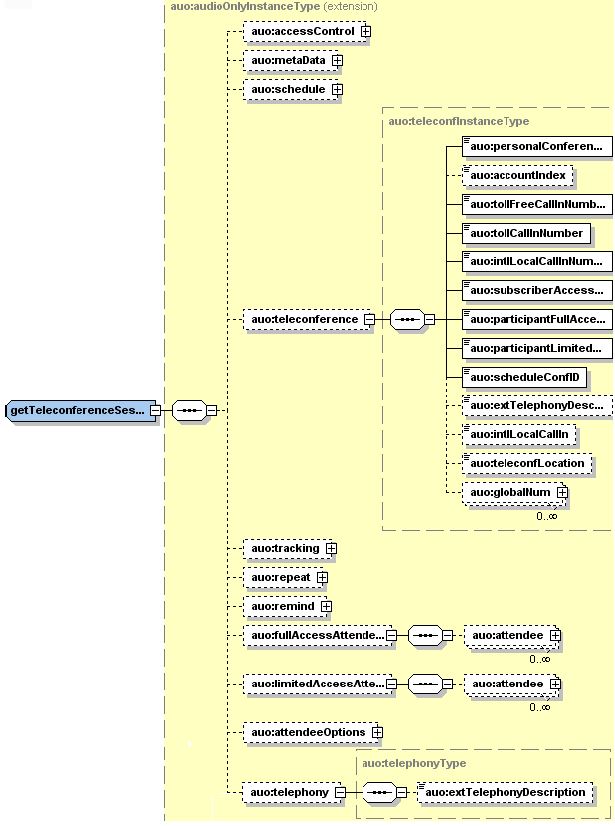GetTeleconferenceSession
Gets detailed information about the specified teleconference-only session scheduled on your website.
Request
The sample XML document shows an example of a request for the retrieval of the teleconference-only session with the sessionKey value of 37480497. Be sure to provide valid values for a session of your website users.
<?xml version="1.0" encoding="UTF-8"?>
<serv:message xmlns:xsi="http://www.w3.org/2001/XMLSchema-instance">
<header>
<securityContext>
<webExID>hostid</webExID>
<password>hostpassword</password>
<siteID>0000</siteID>
<partnerID>9999</partnerID>
<email>johnsmith@xyz.com</email>
</securityContext>
</header>
<body>
<bodyContent xsi:type=
"java:com.webex.service.binding.meeting.auo.GetTeleconferenceSession">
<sessionKey>37480497</sessionKey>
</bodyContent>
</body>
</serv:message>
The following schema diagram shows the structure of the elements in thegetTeleconferenceSession request message.
Figure 5-12 • Schema diagram for getTeleconferenceSession
For descriptions of the global elements in the security context of the header, see Global Request Elements in Security Context. For descriptions of the non-global elements, refer to “Elements in WebEx XML Schema Definitions for the Meeting Service”.
Response
The sample XML document shows an example of a possible response to the
preceding request document.
<?xml version="1.0" encoding="UTF-8"?>
<serv:message xmlns:serv="http://www.webex.com/schemas/2002/06/service"
xmlns:com="http://www.webex.com/schemas/2002/06/common"
xmlns:auo="http://www.webex.com/schemas/2002/06/service/meeting/auo">
<serv:header>
<serv:response>
<serv:result>SUCCESS</serv:result>
<serv:gsbStatus>PRIMARY</serv:gsbStatus>
</serv:response>
</serv:header>
<serv:body>
<serv:bodyContent xsi:type="auo:getTeleconferenceSessionResponse"
xmlns:xsi="http://www.w3.org/2001/XMLSchema-instance">
<auo:accessControl>
<auo:listing>PUBLIC</auo:listing>
<auo:sessionPassword>111111</auo:sessionPassword>
</auo:accessControl>
<auo:metaData>
<auo:confName>Test Setting Teleconf-only</auo:confName>
<auo:sessionType>16</auo:sessionType>
</auo:metaData>
<auo:schedule>
<auo:startDate>04/18/2015 15:15:17</auo:startDate>
<auo:timeZoneID>16</auo:timeZoneID>
<auo:timeZone>GMT-03:00, S. America Eastern (Brasilia)
</auo:timeZone>
<auo:duration>60</auo:duration>
<auo:entryExitTone>BEEP</auo:entryExitTone>
<auo:hostWebExID>hostid</auo:hostWebExID>
</auo:schedule>
<auo:teleconference>
<auo:extTelephonyDescription>xmlSet</auo:extTelephonyDescription>
</auo:teleconference>
<auo:tracking />
<auo:repeat>
<auo:repeatType>WEEKLY</auo:repeatType>
<auo:expirationDate>04/18/2016 15:15:17</auo:expirationDate>
<auo:dayInWeek>
<auo:day>SATURDAY</auo:day>
<auo:day>TUESDAY</auo:day>
</auo:dayInWeek>
<auo:dayInMonth>0</auo:dayInMonth>
<auo:weekInMonth>0</auo:weekInMonth>
</auo:repeat>
<auo:remind>
<auo:enableReminder>true</auo:enableReminder>
<auo:daysAhead>0</auo:daysAhead>
<auo:hoursAhead>0</auo:hoursAhead>
<auo:minutesAhead>15</auo:minutesAhead>
</auo:remind>
<auo:fullAccessAttendees />
<auo:limitedAccessAttendees />
<auo:attendeeOptions>
<auo:requireUcfDiagnosis>false</auo:requireUcfDiagnosis>
<auo:excludePassword>false</auo:excludePassword>
<auo:requireAccount>false</auo:requireAccount>
</auo:attendeeOptions>
<auo:telephony>
<auo:extTelephonyDescription>xmlSet</auo:extTelephonyDescription>
</auo:telephony>
<auo:hostType>1019001</auo:hostType>
</serv:bodyContent>
</serv:body>
</serv:message>
The following schema diagram shows the structure of the elements in the
getTeleconferenceSessionResponse message.
Figure 5-13 • Schema diagram for getTeleconferenceSessionResponse
The result and exceptionID global elements allow you to confirm that an instantiation request was successful. These elements are described in “Global Response Elements Showing Results and Errors”.

